
Bali Royal Cremation
"Strange as it seems, it is in their cremation ceremonies that the Balinese have their greatest fun. A cremation
is an occasion for gaiety and not for mourning, since it represents the
accomplishment of their most sacred duty: the ceremonial burning of the
corpses of the dead to liberate their souls so that they can thus attain
the higher worlds and be free for reincarnation into better beings" ...Miguel
Covarrubias
Every 5 years, it's time for Cremations. ("Year" means the Bali year
of 210 days, composed of 6 months of 5 weeks of 7 days. The
calendar is strange!) People are buried temporarily until
this time, but they must be cremated "as otherwise the path to reincarnation
is cut off". It's possible to have a separate cremation without burial,
without waiting, if your family is willing to pay the substantial cost.
The primary organization in Bali is the Banjar, which is like
a parish - size about 300-600 people, with 3 temples. Banjars are
organized into Desas , villages. The largest organization within
Bali is the kingdom; the kings are no longer recognized, but the kingdoms
still exist, and are part of the postal addresses. There's a cremation
for each Desa. Each Banjar has 3 temples; the Desa uses one
of them for community cremations. In our week in the Ubud area, we
saw preparations for 5 different cremations, for as many as 93 people.
Of these, the most impressive took place in the center of Ubud. It
included a royal cremation, of a cousin (or a sister-in-law? - the Balinese that
we asked weren't sure of the correct English) of the former King of the
Ubud area.
Click on a picture to enlarge it. Then click on the big picture to go to the next one.
"Full Screen" recommended - use the F11 key to turn it on and off.
A parade of gifts for the families of the deceased
During the week before cremation, the members of the Banjar bring gifts
to the families of the deceased. In turn, the families feed everybody
in the Banjar, and entertain them with a gamelan band. Here are pictures
of the parade of the gift givers and their music:



Building a bull as a funeral pyre for the royal
Meanwhile, in the front yard of a house on Ubud's main street, they're
building a bull, which will be the funeral pyre for the royal. It's built
from bamboo, then covered by velvet and decorated with tinsel and spangles:
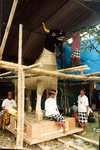
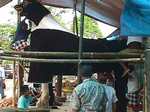
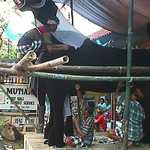
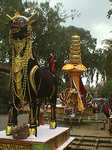
Carrying the bull and tower to the cremation site
After the street is washed, the bull and tower are picked up and carried
to the cremation site. Holy water is spritzed on the carriers.
The course is uneven, with much shaking, to shake off any evil spirits
that may be hanging around. It's exciting, which is my excuse for
the wobbly pictures.
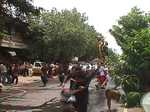
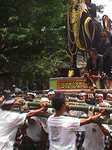
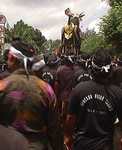
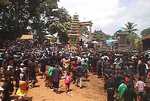
Moving the body to the bull
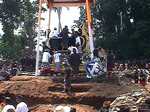
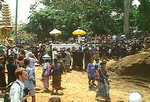
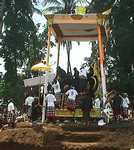

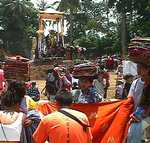
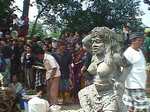
The cremation fire
After more white cloth is layered, and wood is piled below, the bull
is set on fire -
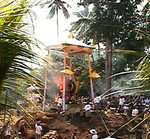
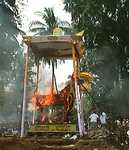
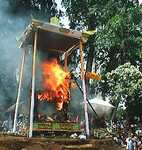
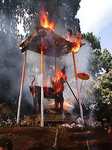
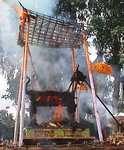


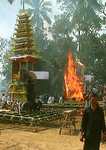
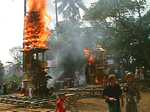
The next morning, the ashes are taken to the ocean.
Pictures by Sue Wright
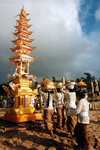
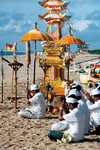
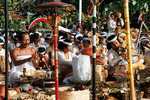

Other Sources on Bali Royal Cremations
There are many posts by visitors to Bali on the Bali Travel Forum,
including one by Debe Campbell on
"Farewell to a King"
Kurt Vlaminck has a site on Bali with 450 pictures, including a cremation at Dukunbuahan.

This page last updated 2008 01 08.
home | john | max
Created using Thotor, Photo Thumbnail Generator!






























